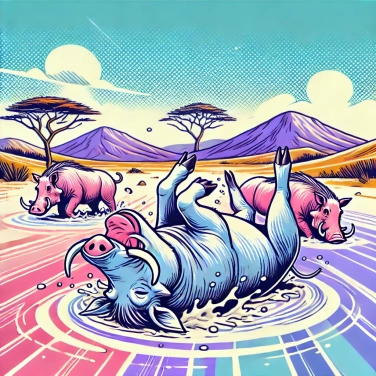Warthogs roll in the mud to protect themselves from parasites and regulate their body temperature. The mud acts as a natural sunscreen and insect repellent, promoting the well-being of the animals.

The warthog loves to dive headfirst into the mud for a very simple reason: it brings him well-being. He actively rolls around in it to scratch himself, relax, but also to reduce his stress and anxiety. This muddy rolling ritual releases accumulated tension, especially after a fight with a peer or when he feels threatened. For some individuals, it’s almost a reflex when nervousness increases: joyfully wallowing in the muck allows the warthog to quickly regain emotional balance and a more serene state.
For warthogs, mud acts like a kind of natural air conditioner. These wild pigs don’t have a thick coat to protect them from the sun, and they lack the effective sweat glands that humans have. Therefore, wallowing in mud allows them to maintain a comfortable body temperature during extreme heat. As it dries, the layer of wet mud cools the body and prevents heat strokes (hyperthermia). Moreover, when this mud dries, it forms an insulating barrier that slows down the warming of the skin under the intense rays of the African sun. Handy, right?
Warthogs regularly cover themselves in mud to avoid parasites and other annoying critters like ticks or biting flies. As it dries, this layer of mud forms a sort of protective crust that traps or suffocates these parasites. When the animal scratches or rubs against something, the dried mud falls off along with the insects trapped inside. Clever and eco-friendly, like a natural mosquito repellent! This habit reduces the risk of infections and keeps the warthog's skin healthier.
For warthogs, rolling in the mud is not just practical; it also helps with social life. Wallowing together in the same puddle strengthens bonds within the group and promotes interactions among individuals. It even sends precise signals: young ones learn to behave by mimicking adults during these muddy baths. Gestures like gently pushing each other or grunting a little establish a sort of hierarchy and allow each member to position themselves within the group. In these very social animals, mud is clearly an original form of non-verbal communication used to maintain a good social dynamic and to clearly display dominance-submission relationships.
Warthogs are not the only fans of mud baths. Domestic pigs, for example, roll in the muck just as much to cool off their bodies, as they hardly sweat either. Rhinoceroses also use mud as a protective cream against parasites and sunburn. For elephants, mud acts as a giant sunscreen for their sensitive skin. In short, everyone has their method, but they all share the same passion for muddy baths, which are practical and economical!
Unlike the European wild boar, warthogs have two pairs of curved tusks: the upper pair is very visible, while the lower pair, shorter and sharper, is primarily used during fights between males.
When they eat, warthogs kneel on their front legs, a unique position among mammals, which facilitates their access to low vegetation.
Although their eyesight is weak, warthogs compensate for their visual impairment with a highly developed sense of smell and hearing.
The term 'warthog' comes from the Greek words 'phaco' (button or wart) and 'choiros' (pig), referring to the characteristic growths on its face.
Indeed, during the dry seasons and very hot periods, warthogs are more likely to engage in this behavior, as it is the time when they fully benefit from the cooling and protective properties of mud to better withstand high temperatures and UV rays.
Yes, rolling in the mud can also play a social role among warthogs. This behavior promotes interaction and group cohesion, thereby strengthening their social bonds through group activities in communal mud baths.
This behavior is primarily instinctive, present from a young age, but young warthogs also learn by imitating their elders. Thus, crawling and lying in the mud quickly become common activities in their daily routines.
Indeed, many wild mammals exhibit this behavior, including elephants, rhinoceroses, wild boars, and even bison. Like warthogs, this activity helps them regulate their body temperature, ward off insects, and protect their skin.
Yes, rolling in the mud is essential for the health of warthogs. It allows them to effectively regulate their body temperature, get rid of parasites, and also protects their skin from the intense UV rays of the sun.

No one has answered this quiz yet, be the first!' :-)
Question 1/5